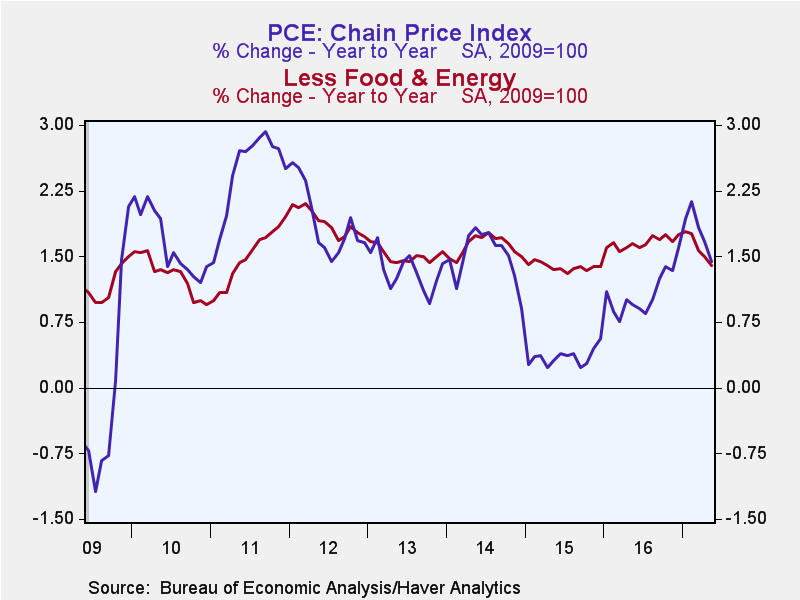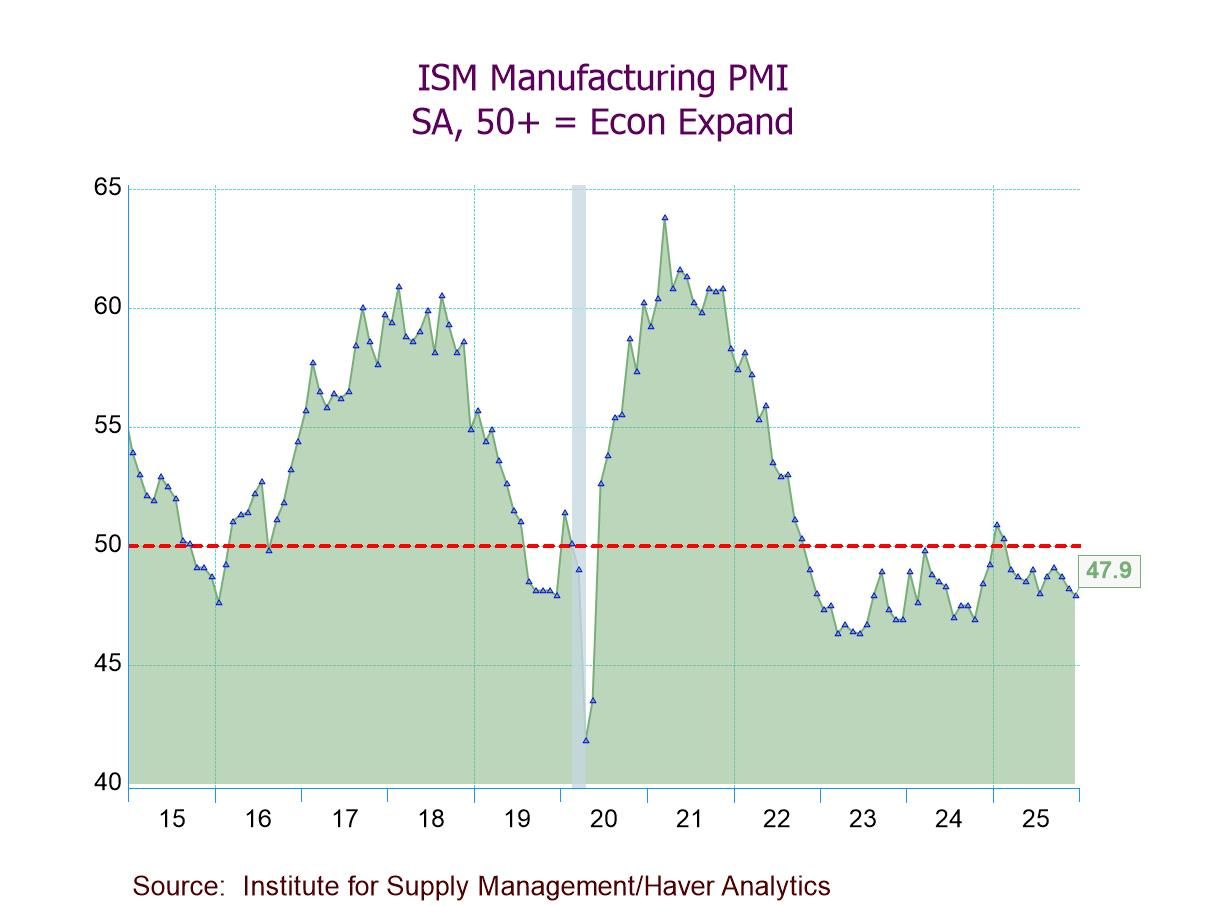 Global| Jun 30 2017
Global| Jun 30 2017U.S. Personal Income Strengthens But Spending Moderates
by:Tom Moeller
|in:Economy in Brief
Summary
Personal income increased 0.4% during May (3.5% y/y) following a 0.3% April rise, revised from 0.4%. The gain outpaced expectations for a 0.3% advance in the Action Economics Forecast Survey. Wages & salaries ticked just 0.1% higher [...]
Personal income increased 0.4% during May (3.5% y/y) following a 0.3% April rise, revised from 0.4%. The gain outpaced expectations for a 0.3% advance in the Action Economics Forecast Survey. Wages & salaries ticked just 0.1% higher (2.9% y/y), the slowest rise since December, following a 0.5% gain. An outsized 4.8% gain (5.0% y/y) in dividend income offset this weakness as it followed a 0.4% rise. Rental income also was strong as it posted a 0.7% rise (6.8% y/y) for a second straight month. Proprietors' income gained 0.6% (4.6% y/y) and made up a 0.2% decline. Interest income declined 0.4% (+2.9% y/y) for a second straight month. Government transfer receipts ticked 0.1% higher (3.6% y/y) following no change. Medicaid payments increased 0.2% (5.4% y/y) and Medicare payments gained 0.4% (4.3% y/y) for a fourth straight month. Social security payments held steady (3.1% y/y), but unemployment insurance payments fell 2.2% (-12.5% y/y).
Personal consumption expenditures matched expectations as they ticked 0.1% higher (4.2% y/y) after two 0.4% gain. A 0.3% decline (+4.3% y/y) in durable goods purchases held back the increase following a 1.0% jump. Motor vehicle outlays declined 0.6% (+2.3% y/y), down for the fifth consecutive month. Spending on home furnishings and appliances fell 0.4% (+2.0% y/y) and reversed a 0.4% increase. Recreational goods & vehicle outlays were off 0.4% (+8.8% y/y), but rose 13.9% y/y when adjusted for lower prices. Nondurable goods outlays fell 0.5% (+3.2% y/y) after a 0.5% rise. Gasoline expenditures fell 4.8% (+4.5% y/y), but rose 1.2% (-1.0% y/y) when adjusted for lower prices. Clothing outlays eased 0.1% (-0.2% y/y) and food & beverage spending held steady (+3.2% y/y). Services outlays increased 0.3% (4.5% y/y) after a 0.2% rise. Housing & utilities spending rose 0.8% (4.9% y/y) while health care purchases rose 0.2% (3.9% y/y). Spending on recreation declined 1.1% (+5.5% y/y) after a 0.7% fall.
As the gain in income outpaced the rise in spending, the personal savings rate rose to 5.5%, is highest level since September. Personal saving rose 8.5% (-5.1% y/y).
In constant dollars, disposable income jumped 0.6% (2.2% y/y), the strongest increase since April 2015. Real personal spending gained 0.1% (2.7% y/y), the weakest increase in three months.
The chain price index declined 0.1% (+1.4% y/y) following a 0.2% rise. The index less food & energy rose 0.1% (1.4% y/y). The y/y increase compares to 1.8% three months ago. The nondurable goods price index was pulled 0.8% lower (+1.1 y/y) by a 3.0% decline (+5.3% y/y) in energy prices. The durable goods price index fell 0.2% (-2.5% y/y), the fourth consecutive monthly fall. The services price index improved 0.2% (2.2% y/y). The annual increase was down from 2.5% three months earlier.
The personal income & consumption figures are available in Haver's USECON database with detail in the USNA database. The Action Economics figure is in the AS1REPNA database.
An Update to the Budget and Economic Outlook: 2017 to 2027 from the Congressional Budget Office can be found here.
| Personal Income & Outlays (%) | May | Apr | Mar | May Y/Y | 2016 | 2015 | 2014 |
|---|---|---|---|---|---|---|---|
| Personal Income | 0.4 | 0.3 | 0.2 | 3.5 | 3.4 | 4.4 | 5.2 |
| Wages & Salaries | 0.1 | 0.5 | -0.0 | 2.9 | 3.9 | 5.1 | 5.1 |
| Disposable Personal Income | 0.5 | 0.3 | 0.2 | 3.7 | 3.7 | 3.8 | 5.1 |
| Personal Consumption Expenditures | 0.1 | 0.4 | 0.4 | 4.2 | 3.9 | 3.5 | 4.4 |
| Personal Saving Rate | 5.5 | 5.1 | 5.1 | 6.0 (May '16) |
5.8 | 5.8 | 5.6 |
| PCE Chain Price Index | -0.1 | 0.2 | -0.2 | 1.4 | 1.1 | 0.3 | 1.5 |
| Less Food & Energy | 0.1 | 0.1 | -0.1 | 1.4 | 1.7 | 1.4 | 1.6 |
| Real Disposable Income | 0.6 | 0.2 | 0.4 | 2.2 | 2.6 | 3.5 | 3.5 |
| Real Personal Consumption Expenditures | 0.1 | 0.2 | 0.6 | 2.7 | 2.7 | 3.2 | 2.9 |
Tom Moeller
AuthorMore in Author Profile »Prior to joining Haver Analytics in 2000, Mr. Moeller worked as the Economist at Chancellor Capital Management from 1985 to 1999. There, he developed comprehensive economic forecasts and interpreted economic data for equity and fixed income portfolio managers. Also at Chancellor, Mr. Moeller worked as an equity analyst and was responsible for researching and rating companies in the economically sensitive automobile and housing industries for investment in Chancellor’s equity portfolio. Prior to joining Chancellor, Mr. Moeller was an Economist at Citibank from 1979 to 1984. He also analyzed pricing behavior in the metals industry for the Council on Wage and Price Stability in Washington, D.C. In 1999, Mr. Moeller received the award for most accurate forecast from the Forecasters' Club of New York. From 1990 to 1992 he was President of the New York Association for Business Economists. Mr. Moeller earned an M.B.A. in Finance from Fordham University, where he graduated in 1987. He holds a Bachelor of Arts in Economics from George Washington University.










